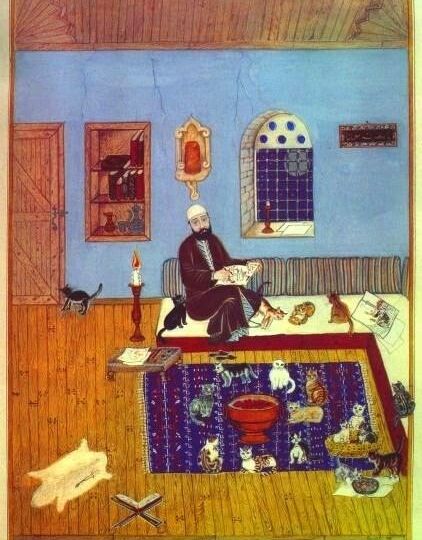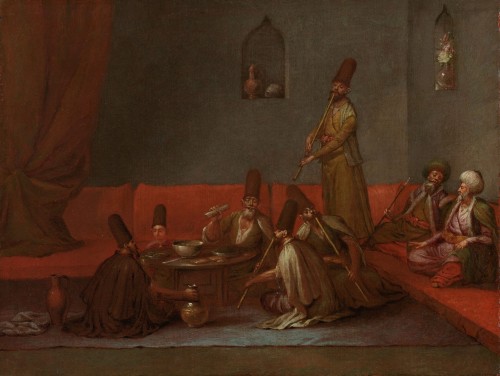
Around the year 1600, residents of Ottoman Istanbul began speculating about a discovery from the New World called tobacco.
Like their contemporaries elsewhere, such as in Europe, the Americas, and in Iran, they would spend the next few decades trying to figure out the value of this strange leaf, not only financially but also morally. Was this new substance a medicine? After all, common wisdom at the time dictated that tobacco was a great cure for many diseases, particularly for diseases of the head and the eye. This medical opinion was disputed by many others, who believed that smoking was harmful, mainly that it was detrimental to reproductive health. Furthermore, its addictive quality was quickly noted as a drawback. Questions about the propriety of tobacco consumption followed. If, indeed, smoking was bad for one’s health, was it morally acceptable to smoke? Even if tobacco was not unhealthy, it was still a bad use of one’s money. Smoking did not quench thirst, nor did it satisfy hunger. So, how could anyone justify spending money on it?
Perhaps most interestingly, many Ottoman observers likened tobacco to wine. They argued that the effects of tobacco on the mind and mood were comparable to that of wine, which was why smoking should be prohibited. Earlier in the sixteenth century another substance was likened to wine: coffee. Today we think of coffee and tobacco as stimulants, and thus consider them to have the opposite effect of intoxicants like alcohol. In the early modern era, however, these substances were often grouped together as pleasurable substances (mükeyyifat), referring less to their specific physical effect than the mood and rituals of consumption they elicit. Indeed, much of the moral fury about the consumption of tobacco was aimed at the state and manners of smokers rather than the physical effects of tobacco. Smokers were shamed for simply sitting around idly the entire day. They laughed too much, and did not stop laughing or wear a solemn expression as they should when someone of a higher rank joined them. They did not work enough, nor care about their responsibilities.
The various objections to tobacco were not merely quibbles among the common folk. Authorities periodically declared tobacco bans in the first half of the century. These bans were mostly justified by fire hazards; the Istanbul Fire of 1633, which destroyed a large area, was traced back to a careless smoker. Another concern for the state was the price of consumption goods, which increased as more farmers preferred to cultivate tobacco rather than less profitable agricultural products. Despite these justifications, however, many contemporary observers believed that the bans were aimed at imposing discipline on an unruly urban public. This observation explains why smoking was punished much more severely than other forms of intoxication. In the 1630s, during the reign of Murad IV, smoking was a capital offense in the original sense of the term: one could be decapitated for disobedience for smoking. These efforts to eradicate smoking are well known today, having entered schoolbooks and popular culture.
Less famous are the eloquent, elaborate literary defenses of tobacco written by many Istanbulites. The Mevlevi order of Sufis were quite active in this pro-tobacco campaign during the tobacco bans under Murad IV and long after. Around the end of the century, when tobacco decapitations were but stories from the past, a Mevlevi dervish wrote a laudatory ode to tobacco that ascribes it a distinguished place in the life of the mind. This dervish was Fasih Ahmed Dede (d. 1699), a poet, prose writer, musician, calligrapher, and painter.
Fasih Ahmed Dede’s short treatise is entitled ‘Tenbakūnāme’, which loosely translates to Ode to Hookah. His praise is reserved for smoking from a hookah and long pipes, which befits a gentleman much better than the cheap, common clay pipe. The hookah allows him to mix tobacco with fragrant herbs, so that the fine gentleman oozes floral scents rather than the stench of tobacco. In many ways, Fasih Dede’s ‘Ode to Hookah’ elevates tobacco from a mundane addiction to a mark of a refined gentleman. He likens the long pipe to the ney, the flute that has been one of the symbols of the Mevlevi music and of Rumi’s poetry, mentioned in the opening couplet of Rumi’s Mesnevi. The flute-hookah analogy was a popular one, as visualized in the depictions of life in Istanbul in the early eighteenth century by the Flemish artist Jean Baptiste Vanmour. Vanmour’s depiction of a group of dervishes socializing after a shared meal makes playful use of the visual semblance between the Mevlevi ‘ney’ and the long pipes for smoking.

Fasih Dede connects tobacco with art and inspiration; the long pipe is the best confidant for the musician, as well as for the writer and the poet. Among the intoxicants, this place of honor had long been reserved for wine, considered the sophisticated drink of the intellectual and the poet. In the ‘Ode to Hookah’ the author wants to unseat wine and enthrone tobacco as the finest of intoxicants. “Countless poets have praised the wine,” writes Fasih Dede, but only a select few have appreciated tobacco. With this eulogy for tobacco, he makes himself a place among the select few. The following is a short excerpt from Fasih Ahmed Dede’s ‘Ode to Hookah’:
“(…) While wine makes visible the color of pleasure, tobacco certainly has a certain warmth, accompanied by a sweet scent, which pleases the heart. While wine causes one’s thoughts to become dispersed, tobacco helps one gather thoughts when dispersed. While wine induces sleep and therefore eats away one’s lifetime, tobacco induces wakefulness, thereby lengthening one’s lifetime, which is his most precious belonging. Sure, wine may claim distinction with its acclaimed ruby color. Yet, tobacco has a privilege: it flirts with the beloved, kissing their sweet lips.
One always needs company, even a confidant, to drink wine. Tobacco is company and confidant incarnate. Wine only leads to meaningless babbling and pointless chit chat. Tobacco leads to quiet, even silence; it stops people from talking nonsense. If alcohol is an unruly, uncontrollable wildfire, tobacco is a fragrant fire that smacks of flowers. Alcohol is a shameless rambler in the hands of every man (…), tobacco is reserved for one person’s hands.
The boiling of the hookah is so overflowing that it bursts a thousand hyacinths in a moment.
(…)The hookah is like a nightingale in a garden of violets, singing a thousand harmonious melodies. The hookah, resembling a rare hyacinth or a sugar cane, suits writers with their sweet words, easing and enthusing them. (…) (Tobacco) is like a rare, beautiful cloth that enthralls all the tradesmen of Iraq and Damascus.”
Fig.1: Fasih Ahmed Dede depicted in his chamber at the Galata Mevlevi Lodge, where he resided most of his life and taught calligraphy lessons.

